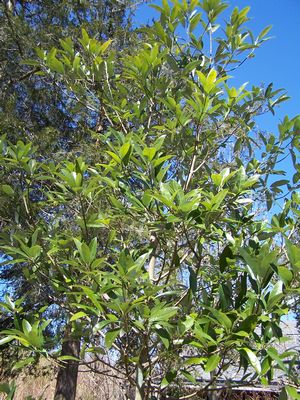View All Plants :: View All TREES
Magnolia virginiana 'Henry Hicks'
Sweetbay Magnolia
Plant Type:
TREESMagnolia virginiana ‘Henry Hicks’ – 'Henry Hicks' is a very hardy, evergreen form of the Sweetbay Magnolia. It retains most of its foliage for us in USDA zone 5b sited in moist, fertile soil in part shade somewhat sheltered from the west by red cedars. The foliage is oblong and about 4” to 5” long, rich glossy green with pale, glaucous undersides. The citrus scented flowers occur throughout the summer but are absent on young trees… give it a few years and your patience will be rewarded. During the hard winter of 2009 when over night temperatures plummeted into the lower minus teens (USDA zone 5b) on at least 3 occasions ‘Henry Hicks’ huddled under its cloak of green leaves and emerged unscathed. What a remarkable tree! Northern gardeners: please purchase and plant only in spring.
Characteristics and Attributes for Magnolia virginiana 'Henry Hicks'
Season of Interest (Flowering)
- Summer
Season of Interest (Foliage)
- Four Seasons
Nature Attraction
- Deer Resistant
Light
- Morning Sun / Afternoon Shade
- Dappled Shade
Attributes
- Alee
- Evergreen
- Fragrant
- Specimen
Growth Rate in the Garden
- Medium
Soil
- Fertile
- Organic
- Moist
Origins
- Garden Origin
Propagated By
- Cutting Grown
Genus Overview: Magnolia
Common Name: Magnolia
The Magnolias are one of the earliest known flowering plants to establish themselves on our beautiful planet. Much breeding continues and the cultivar list is expanding with some smaller sizes and new flower colors. Many are typical tree forms while some tend to be multi-stemmed – more like huge shrubs than single-stemmed trees. Most are spring blooming – some early, others later after danger of frost has passed in the north. A few of these will provide some recurrence of bloom during the summer. A handful bloom in summer. Many emit wonderful fragrance. The foliage is often large, bold and paddle-shaped, looking attractive in summer; a handful of species’ leaves are so large that they are reminiscent of banana foliage. Some seasons they develop gold to golden brown autumn color before the leaves drop. It’s hard for me to think of a landscape without one or more included in the mix. All prefer fertile deep loam with plenty of organic matter and moist soils – some are even content in relatively wet conditions. Magnolias should be sited in full to half sun exposures. All our selections are cutting grown, on their own wood – they are not grafted. Some are much easier to produce on their own wood than others; some are quite recalcitrant. In that, we may not always have certain plants available or available in great numbers. Spring planting is recommended for magnolias especially up north. Cutting grown.
